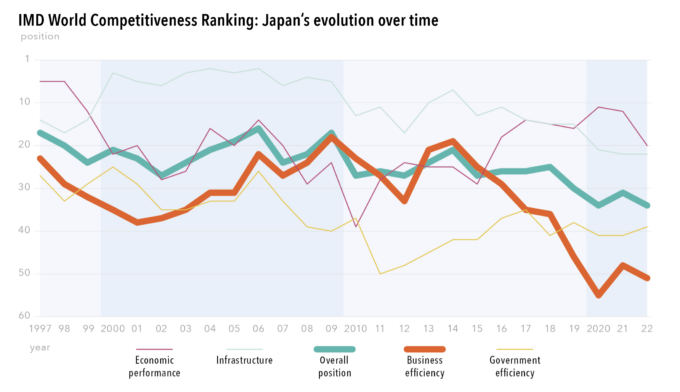The devil lies in the detail
In the 2022 IMD World Competitiveness Ranking (WCR), Japan was placed 34 out of 63 economies. In 2006, it was 16th – the highest it has been since it entered our rankings in 1997.
Japanese infrastructure is good (it came 22nd in this pillar). But its public sector is ineffective and its private sector paralyzed, both of which have knock-on effects on economic performance (39th in 2022 and 11th in 2020) and business efficiency (51st in 2022, and in freefall since 2014 – see graph for details).
Japan has never fostered the productivity of small and medium enterprises and it has weak muscle power in innovation and digital prowess as a result.
Against a fairly rigid business environment, the widening productivity gap between large enterprises and SMEs has dragged down productivity and performance.
At the WCC, we advise economies to draw on their strengths. Japan has long been a front-runner in technological developments, but it has taken its eye off the ball. In the auto industry, Toyota and Mitsubishi are struggling to stay relevant in the face of competition from the Chinese. It has also lost its dominance in semiconductors and consumer electronics.
An unequal, top-heavy society
Competitiveness is synonymous with quality of life, and Japan’s living standards have steadily eroded. The pandemic exposed systemic inequalities from the past. While all developed countries experience demographic decline, the situation is untenable in Japan. Last year, nearly twice as many people died as were born, and many people who are childless would be thrown into poverty if they started a family.
With a disproportionately elderly population, a lot of money goes into pensions – and upskilling just isn’t a thing. The 55-year-old who has been in the same company his or her entire working life is either not interested in further training or not offered the opportunity. The government is trying to invest in reskilling, but it has a massive amount of debt.
Japan has come late to the game of attracting foreign talent with the introduction of new visa pathways. An important next step is to eliminate differential treatment between men and women and level opportunities for non-regular workers.


 Audio available
Audio available





